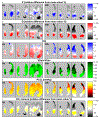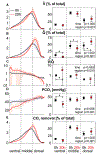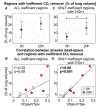Physiological mechanism and spatial distribution of increased alveolar dead-space in early ARDS: An experimental study
- PMID: 32931610
- PMCID: PMC9846860
- DOI: 10.1111/aas.13702
Physiological mechanism and spatial distribution of increased alveolar dead-space in early ARDS: An experimental study
Abstract
Background: We aimed to investigate the physiological mechanism and spatial distribution of increased physiological dead-space, an early marker of ARDS mortality, in the initial stages of ARDS. We hypothesized that: increased dead-space results from the spatial redistribution of pulmonary perfusion, not ventilation; such redistribution is not related to thromboembolism (ie, areas with perfusion = 0 and infinite ventilation-perfusion ratio, ), but rather to moderate shifts of perfusion increasing in non-dependent regions.
Methods: Five healthy anesthetized sheep received protective ventilation for 20 hours, while endotoxin was continuously infused. Maps of voxel-level lung ventilation, perfusion, , CO2 partial pressures, and alveolar dead-space fraction were estimated from positron emission tomography at baseline and 20 hours.
Results: Alveolar dead-space fraction increased during the 20 hours (+0.05, P = .031), mainly in non-dependent regions (+0.03, P = .031). This was mediated by perfusion redistribution away from non-dependent regions (-5.9%, P = .031), while the spatial distribution of ventilation did not change, resulting in increased in non-dependent regions. The increased alveolar dead-space derived mostly from areas with intermediate (0.5≤ ≤10), not areas of nearly "complete" dead-space ( >10).
Conclusions: In this early ARDS model, increases in alveolar dead-space occur within 20 hours due to the regional redistribution of perfusion and not ventilation. This moderate redistribution suggests changes in the interplay between active and passive perfusion redistribution mechanisms (including hypoxic vasoconstriction and gravitational effects), not the appearance of thromboembolism. Hence, the association between mortality and increased dead-space possibly arises from the former, reflecting gas-exchange inefficiency due to perfusion heterogeneity. Such heterogeneity results from the injury and exhaustion of compensatory mechanisms for perfusion redistribution.
© 2020 The Acta Anaesthesiologica Scandinavica Foundation. Published by John Wiley & Sons Ltd.
Conflict of interest statement
CONFLICTS OF INTEREST
Alessandro Beda is presently employed by Hamilton Medical AG, but the study, analysis, and drafting of the manuscript were performed before his employment, without any participation of Hamilton Medical AG. All other authors have disclosed that they do not have any conflicts of interest.
Figures




Similar articles
-
Absolute values of regional ventilation-perfusion mismatch in patients with ARDS monitored by electrical impedance tomography and the role of dead space and shunt compensation.Crit Care. 2024 Jul 15;28(1):241. doi: 10.1186/s13054-024-05033-8. Crit Care. 2024. PMID: 39010228 Free PMC article.
-
Impact of cardiac output and alveolar ventilation in estimating ventilation/perfusion mismatch in ARDS using electrical impedance tomography.Crit Care. 2023 May 8;27(1):176. doi: 10.1186/s13054-023-04467-w. Crit Care. 2023. PMID: 37158963 Free PMC article.
-
Electrical impedance tomography and heterogeneity of pulmonary perfusion and ventilation in porcine acute lung injury.Acta Anaesthesiol Scand. 2009 Nov;53(10):1300-9. doi: 10.1111/j.1399-6576.2009.02103.x. Epub 2009 Aug 31. Acta Anaesthesiol Scand. 2009. PMID: 19719814
-
Therapeutic benefits of proning to improve pulmonary gas exchange in severe respiratory failure: focus on fundamentals of physiology.Exp Physiol. 2022 Jul;107(7):759-770. doi: 10.1113/EP089405. Epub 2021 Aug 13. Exp Physiol. 2022. PMID: 34242438 Free PMC article. Review.
-
[Gas exchange in acute respiratory distress syndrome].Medicina (B Aires). 2003;63(2):157-64. Medicina (B Aires). 2003. PMID: 12793087 Review. Spanish.
Cited by
-
Lung functional imaging.Breathe (Sheff). 2023 Sep;19(3):220272. doi: 10.1183/20734735.0272-2022. Epub 2023 Nov 14. Breathe (Sheff). 2023. PMID: 38020338 Free PMC article.
-
Worsening of lung perfusion to tissue density distributions during early acute lung injury.J Appl Physiol (1985). 2023 Aug 1;135(2):239-250. doi: 10.1152/japplphysiol.00028.2023. Epub 2023 Jun 8. J Appl Physiol (1985). 2023. PMID: 37289955 Free PMC article.
-
Imaging the pulmonary vasculature in acute respiratory distress syndrome.Nitric Oxide. 2024 Jun 1;147:6-12. doi: 10.1016/j.niox.2024.04.004. Epub 2024 Apr 6. Nitric Oxide. 2024. PMID: 38588918 Free PMC article. Review.
-
The end-tidal alveolar dead space fraction for risk stratification during the first week of invasive mechanical ventilation: an observational cohort study.Crit Care. 2023 Feb 9;27(1):54. doi: 10.1186/s13054-023-04339-3. Crit Care. 2023. PMID: 36759925 Free PMC article.
-
Effects of Lung Expansion on Global and Regional Pulmonary Blood Volume in a Sheep Model of Acute Lung Injury.Anesthesiology. 2025 Jun 1;142(6):1071-1084. doi: 10.1097/ALN.0000000000005412. Epub 2025 Feb 12. Anesthesiology. 2025. PMID: 39946655
References
-
- Nuckton TJ, Alonso JA, Kallet RH, et al. Pulmonary dead-space fraction as a risk factor for death in the acute respiratory distress syndrome. N Engl J Med. 2002;346:1281–1286. - PubMed
-
- Lucangelo U, Bernabè F, Vatua S, et al. Prognostic value of different dead space indices in mechanically ventilated patients with acute lung injury and ARDS. Chest. 2008;133:62–71. - PubMed
-
- Kallet RH, Alonso JA, Pittet J-F, Matthay MA. Prognostic value of the pulmonary dead-space fraction during the first 6 days of acute respiratory distress syndrome. Respir Care. 2004;49:1008–1014. - PubMed
-
- West JB, Dollery CT, Naimark A. Distribution of blood flow in the isolated lung; relation to vascular and alveolar pressures. J Appl Physiol. 1964;19:713–724. - PubMed
Publication types
MeSH terms
Grants and funding
LinkOut - more resources
Full Text Sources

